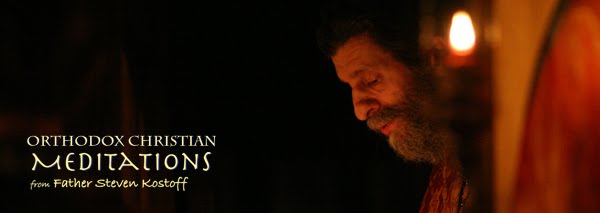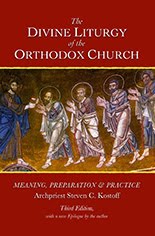Dear Parish Faithful & Friends in Christ,
The issue of "atonement" was raised and discussed at Sunday's post-Liturgy discussion, and we could only touch on it briefly. That discussion, though, has led me to once again share a meditation from the past (2013) on that theme worked out with an eye on briefly explaining our Orthodox perspective - turning to the Scriptures and the Fathers - within the wider context of how we react to other theories of the atonement that seem problematic to us.
An Orthodox Christian perspective
on the Cross of Christ
Having come to the middle point of the path of the Fast that leads to Thy precious Cross, grant that we may see Thy day that Abraham saw and rejoiced, when on the mountain he received Isaac back alive as from the tomb. Delivered from the enemy by faith, may we share Thy mystical supper, calling upon Thee in peace: Our light and our Savior, glory to Thee!
[Matins of Wednesday in the Fourth Week of Great Lent]
The misunderstanding may still persist that the Orthodox Church downplays the significance of the Cross because it so intensely concentrates on the Resurrection, or on other such themes as transfiguration, deification, mystical encounter with God, and so forth. This is an implicit criticism that there is some deficiency in the Orthodox Christian presentation of the place of the Cross in the divine dispensation “for us and for our salvation.”
Such criticism may not hold up under further reflection and inspection, for the Orthodox would say that based upon the divine economy of our salvation, resurrection – and any “mystical encounter” with God – is only possible through the Cross.
As this was “the purpose of his will” and “the mystery of his will” (Ephesians 1:5,9), our salvation could not have been accomplished in any other way. The “Lord of Glory” was crucified (1 Corinthians 2:8) and then raised from the dead. Elsewhere, the Apostle Paul writes that “Jesus our Lord” was “put to death for our trespasses and raised for our justification” (Romans 4:25).
The author of the Epistle to the Hebrews writes of “Jesus the pioneer and perfecter of our faith, who for the joy that was set before him endured the shame, and is seated at the right hand of the throne of God” (Hebrews 12:2). A text such as this could be behind the hymn we sing at every Divine Liturgy after receiving the Eucharist: “For through the Cross, joy has come into the world.”
Jesus himself said “that the Son of Man must suffer many things…and be killed and after three days rise again” (Mark 8: 31). Of the Greek word translated as “must” from these words of Christ, Archbishop Demitrios Trakatellis wrote:
“This expresses the necessity (dei) of the Messiah’s terrible affliction. Judging from the meaning of the verb (dei) in Mark, this necessity touches upon God’s great plan for the salvation of the world” (Authority and Passion, p.51-52).
Many such texts can be multiplied, but the point is clear: The Cross and the empty tomb – redemption and resurrection – are inseparably united in the one paschal mystery that is nothing less than “Good News.” Like Mary Magdalene before us, one must first stand by the Cross in sober vigilance before gazing with wonder into the empty tomb and then encountering the Risen Lord (John 20:11-18).
As something of an aside, part of this misunderstanding of the Orthodox Church’s supposed neglect of the Cross in the drama of human redemption could stem from a one-sided emphasis on the Cross in other churches at the expense of the Resurrection. The redemptive significance of the Cross somehow overwhelms the Resurrection so that it is strangely reduced to something of a glorified appendix to the salvific meaning of the Cross. As Vladimir Lossky wrote: “This redemptionist theology, placing all the emphasis on the passion, seems to take no interest in the triumph of Christ over death.”
Since the “triumph of Christ over death” is so integral to the very existence of the Church—and since it is the ultimate paschal proclamation, as in “Christ is risen from the dead, trampling down death by death!”—then the Orthodox Church will never concentrate on a “theology of the Cross” at the expense of the Resurrection. Rather, the one paschal mystery will always embrace both Cross and Resurrection in a balanced manner. Within the Church during the week of the Cross (beginning on the third Sunday of Great Lent), we sing and prostrate ourselves before the Cross while chanting,
“Before Thy Cross we bow down in worship, and Thy holy Resurrection we glorify!”
In addition, and perhaps more tellingly, the growth, development and continuing existence of certain theories of atonement that have proven to be problematic today, but not shared by the Orthodox Church, have had an impact on evaluating the Orthodox Church’s understanding of the Cross on the whole. These theories of atonement will portray God as being primarily characterized by a wrath that demands appeasement, or “propitiation,” something only the death of His Son on the Cross could “satisfy.” These theories would stress the “judicial” and “penal” side of redemption in a one-sided manner. They may also bind God to act within certain “laws” of eternal necessity that would impose such categories as (vindictive?) justice on God in a way that may obscure God’s overwhelming mercy and love.
Not sharing such theories of atonement as developed in the “West,” the Orthodox Church may face criticism for lacking a fully-developed “theology of the Cross.” However, such “satisfaction” theories of atonement are proving to be quite unsatisfactory in much of contemporary theological assessments of the meaning and significance of the Cross in relation to our salvation “in Christ.”
The Orthodox can make a huge contribution toward a more holistic and integrated understanding of the role of both Cross and Resurrection, so that the full integrity of the paschal mystery is joyfully proclaimed to the world. From the patristic tradition of the Church, the voice of Saint Athanasius the Great can speak to us today of this holistic approach (using some “juridical” language!):
“Here, then is the…reason why the Word dwelt among us, namely that having proved His Godhead by His works, He might offer the sacrifice on behalf of all, surrendering His own temple to death in place of all, to settle man’s account with death and free him from the primal transgression. In the same act also He showed Himself mightier than death, displaying His own body incorruptible as the first-fruit of the resurrection” (On the Incarnation, 20).
In soberly assessing too great of a dependency on juridical language when speaking of redemption, and anticipating some later theories that would narrowly focus on the language of “payment” and “ransom” in relation to the sacrifice of Christ; Saint Gregory the Theologian argued that a “price” or “ransom” was not “paid” to the Father or to Satan, as if either would demand, need or expect such a price as the “precious and glorious blood of God.” Saint Gregory says, rather, the following:
“Is it not evident that the Father accepts the sacrifice not because He demanded it or had any need for it but by His dispensation? It was necessary that man should be sanctified by the humanity of God; it was necessary that He Himself should free us, triumphing over the tyrant by His own strength, and that He should recall us to Himself by His Son who is the Mediator, who does all for the honor of the Father, to whom he is obedient in all things …. Let the rest of the mystery be venerated silently” (Oration 45,22).
However, getting it right in terms of a sound doctrine of atonement is one thing – essential as it is – but assimilating the necessity of the Cross in and to our personal understanding and the conditions of our life is another. In fact, it is quite a struggle and our resistance can be fierce!
If this is difficult to understand, assimilate and then live by, the initial disciples of the Lord suffered through the same profound lack of comprehension. Their (mis)undersanding of Jesus as the Messiah was one-sidedly fixated on images of glory, both for Israel and for themselves. A crucified Messiah was simply too much for the disciples to grasp, ever though Jesus spoke of this in words that were not that enigmatic.
When Peter refused to accept his Master’s words of His impending passion and death in Jerusalem after just confessing His messianic stature and being blessed for it; he is forced to receive what is perhaps the most stinging rebuke in the Gospels when Jesus turns to him and says: “Get behind me Satan! For you are not on the side of God, but of men” (Mark 8:33). It was Satan who did not want Jesus to fulfill His vocation by voluntarily dying on the Cross, so Peter’s refusal to accept Christ’s words was his way of aligning himself with Satan.
The disciples were not enlightened until after the resurrection of their Lord and Master. We are raised in the Church so that we already know of Christ’s triumph over death through the Cross. Our resistance is not based on a lack of knowledge, but of a real human dread of pain and suffering. It may be difficult to us to “see” the joy that comes through the Cross until we find ourselves “on the other side,” for “now we see in a glass darkly, but then face to face” (1 Corinthians 13:12). It is our hope and the “certainty” of our faith that Christ has indeed triumphed over death, “even death on a Cross” (Philippians 2:8).
God has blessed us with yet another Great Lent and upcoming Holy Week and Pascha in order to share in that experience of His glorious triumph that begins with the life-giving wood of the Tree of the Cross.




















